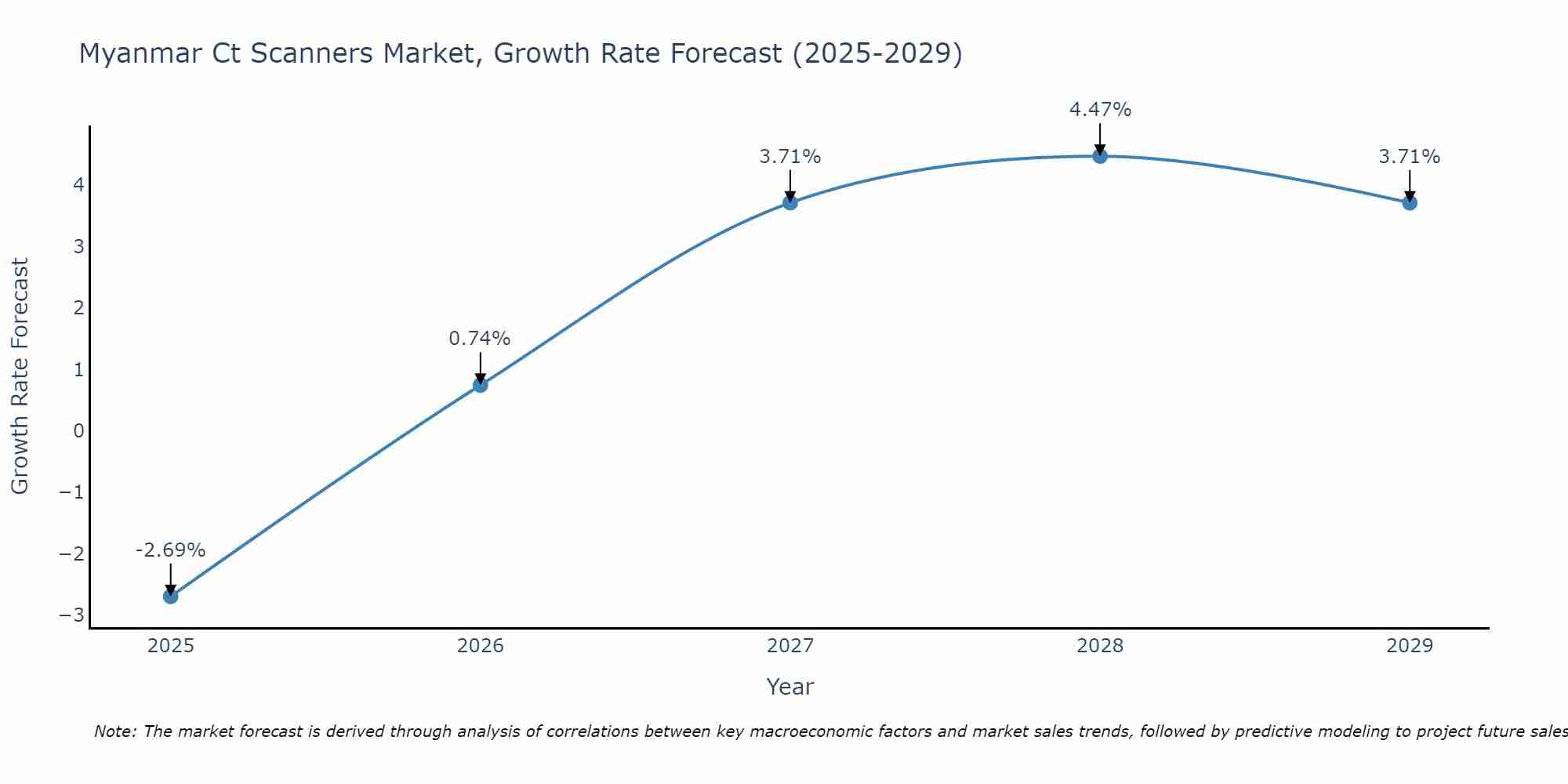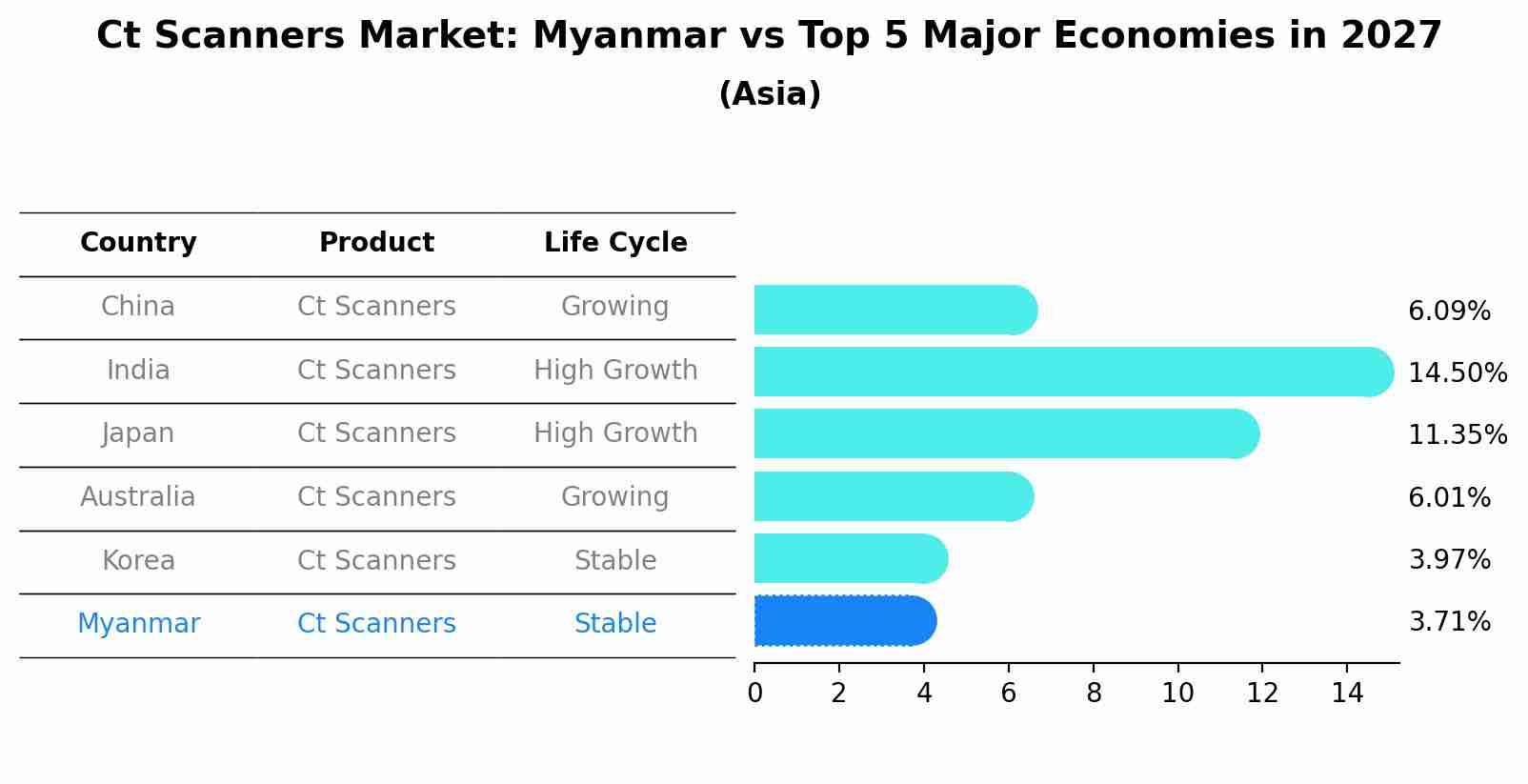Myanmar Ct Scanners Market (2025-2031) Outlook | Industry, Revenue, Growth, Share, Size, Analysis, Trends, Value, Companies & Forecast
| Product Code: ETC362794 | Publication Date: Aug 2022 | Updated Date: Aug 2025 | Product Type: Market Research Report | |
| Publisher: 6Wresearch | Author: Vasudha | No. of Pages: 75 | No. of Figures: 35 | No. of Tables: 20 |
Myanmar Ct Scanners Market Size Growth Rate
The Myanmar Ct Scanners Market is projected to witness mixed growth rate patterns during 2025 to 2029. Starting at -2.69% in 2025, the market peaks at 4.47% in 2028, and settles at 3.71% by 2029.

Ct Scanners Market: Myanmar vs Top 5 Major Economies in 2027 (Asia)
In the Asia region, the Ct Scanners market in Myanmar is projected to expand at a stable growth rate of 3.71% by 2027. The largest economy is China, followed by India, Japan, Australia and South Korea.

Myanmar Ct Scanners Market Synopsis
The Myanmar CT scanners market is experiencing steady growth, driven by increasing healthcare infrastructure development and rising demand for advanced diagnostic technologies. The market is primarily dominated by multinational companies offering a range of CT scanner products with varying levels of technology and pricing. Public and private hospitals, diagnostic centers, and clinics are the primary end-users of CT scanners in Myanmar. The demand for CT scanners is expected to further increase due to the growing prevalence of chronic diseases, increasing healthcare expenditure, and a focus on improving healthcare services in the country. Key players in the Myanmar CT scanners market are focusing on product innovation, strategic partnerships, and collaborations to enhance their market presence and cater to the evolving needs of healthcare providers in the region.
Myanmar Ct Scanners Market Trends
The Myanmar CT scanners market is witnessing steady growth due to increasing healthcare infrastructure development and rising demand for advanced medical diagnostics. Key trends include the adoption of high-end CT scanner models with advanced imaging capabilities, such as dual-source CT scanners and spectral CT technology, to improve diagnostic accuracy and efficiency. Additionally, there is a growing focus on expanding access to CT scanning services in rural areas through mobile or portable CT scanners, enabling healthcare providers to reach underserved populations. The market is also seeing a rise in partnerships and collaborations between medical equipment manufacturers and local healthcare providers to enhance service offerings and drive market penetration. Overall, the Myanmar CT scanners market is poised for continued growth driven by technological advancements and increasing healthcare investments.
Myanmar Ct Scanners Market Challenges
In the Myanmar CT scanners market, there are several challenges faced by industry players. One major challenge is the limited healthcare infrastructure and resources in the country, which hinders the adoption and usage of advanced medical imaging technologies like CT scanners. Additionally, the high cost associated with purchasing and maintaining CT scanners poses a significant barrier for healthcare facilities, especially in remote or underserved areas. Furthermore, the lack of skilled professionals and trained technicians to operate and interpret the results of CT scans is another challenge that impacts the effective utilization of this technology. These challenges require strategic planning and investment in infrastructure, training programs, and financing options to overcome and improve access to quality healthcare services in Myanmar.
Myanmar Ct Scanners Market Investment Opportunities
Investment opportunities in the Myanmar CT scanners market are promising due to the country`s growing healthcare sector and increasing demand for advanced medical imaging technology. With a rising incidence of chronic diseases and a focus on improving healthcare infrastructure, there is a need for more CT scanners to enhance diagnostic capabilities. Investors can consider opportunities in supplying CT scanners to hospitals, clinics, and diagnostic centers, as well as offering maintenance services and training programs. Additionally, partnerships with local healthcare providers and government initiatives to improve healthcare access and quality could create a conducive environment for investment in the Myanmar CT scanners market. Investing in cutting-edge technology, reliable after-sales support, and understanding the regulatory environment will be crucial for success in this market.
Jordan Agar Market Government Policies
Government policies related to the Myanmar CT Scanners Market are primarily focused on regulatory approval processes, import/export regulations, and quality standards compliance. The Ministry of Health and Sports oversees the registration and approval of medical devices, including CT scanners, to ensure they meet safety and performance requirements. Importation of CT scanners is subject to licensing and customs regulations, with specific documentation and fees required for bringing these devices into the country. Additionally, the government has set standards for healthcare facilities to ensure proper maintenance, calibration, and usage of CT scanners to guarantee accurate and reliable diagnostic results. Adherence to these policies is essential for manufacturers, distributors, and healthcare providers operating in the Myanmar CT Scanners Market to ensure compliance and quality of services provided to patients.
Myanmar Ct Scanners Market Future Outlook
The Myanmar CT Scanners market is expected to exhibit significant growth in the coming years, driven by factors such as increasing healthcare infrastructure development, rising incidences of chronic diseases, and a growing awareness of the benefits of early disease detection. The market is likely to experience a surge in demand for advanced CT scanners equipped with the latest technology, such as high-resolution imaging and faster scan times. Additionally, government initiatives aimed at improving healthcare access and quality are anticipated to further propel market growth. However, challenges such as limited healthcare budget allocations and a shortage of skilled healthcare professionals may hinder market expansion to some extent. Overall, the Myanmar CT scanners market is poised for robust growth opportunities in the foreseeable future.
Key Highlights of the Report:
- Myanmar Ct Scanners Market Outlook
- Market Size of Myanmar Ct Scanners Market, 2024
- Forecast of Myanmar Ct Scanners Market, 2031
- Historical Data and Forecast of Myanmar Ct Scanners Revenues & Volume for the Period 2021 - 2031
- Myanmar Ct Scanners Market Trend Evolution
- Myanmar Ct Scanners Market Drivers and Challenges
- Myanmar Ct Scanners Price Trends
- Myanmar Ct Scanners Porter's Five Forces
- Myanmar Ct Scanners Industry Life Cycle
- Historical Data and Forecast of Myanmar Ct Scanners Market Revenues & Volume By Type for the Period 2021 - 2031
- Historical Data and Forecast of Myanmar Ct Scanners Market Revenues & Volume By Stationary CT scanners for the Period 2021 - 2031
- Historical Data and Forecast of Myanmar Ct Scanners Market Revenues & Volume By Portable CT scanners for the Period 2021 - 2031
- Historical Data and Forecast of Myanmar Ct Scanners Market Revenues & Volume By Device Architecture for the Period 2021 - 2031
- Historical Data and Forecast of Myanmar Ct Scanners Market Revenues & Volume By C-arm CT Scanners for the Period 2021 - 2031
- Historical Data and Forecast of Myanmar Ct Scanners Market Revenues & Volume By O-arm CT Scanners for the Period 2021 - 2031
- Historical Data and Forecast of Myanmar Ct Scanners Market Revenues & Volume By Technology for the Period 2021 - 2031
- Historical Data and Forecast of Myanmar Ct Scanners Market Revenues & Volume By High-slice CT for the Period 2021 - 2031
- Historical Data and Forecast of Myanmar Ct Scanners Market Revenues & Volume By Mid-slice CT for the Period 2021 - 2031
- Historical Data and Forecast of Myanmar Ct Scanners Market Revenues & Volume By Low-slice CT for the Period 2021 - 2031
- Historical Data and Forecast of Myanmar Ct Scanners Market Revenues & Volume By Cone-beam CT for the Period 2021 - 2031
- Historical Data and Forecast of Myanmar Ct Scanners Market Revenues & Volume By Application for the Period 2021 - 2031
- Historical Data and Forecast of Myanmar Ct Scanners Market Revenues & Volume By Human Application for the Period 2021 - 2031
- Historical Data and Forecast of Myanmar Ct Scanners Market Revenues & Volume By Diagnostic Applications for the Period 2021 - 2031
- Historical Data and Forecast of Myanmar Ct Scanners Market Revenues & Volume By Cardiology Applications for the Period 2021 - 2031
- Historical Data and Forecast of Myanmar Ct Scanners Market Revenues & Volume By Oncology Applications for the Period 2021 - 2031
- Historical Data and Forecast of Myanmar Ct Scanners Market Revenues & Volume By Neurology Applications for the Period 2021 - 2031
- Historical Data and Forecast of Myanmar Ct Scanners Market Revenues & Volume By Intraoperative Applications for the Period 2021 - 2031
- Historical Data and Forecast of Myanmar Ct Scanners Market Revenues & Volume By Veterinary Application for the Period 2021 - 2031
- Historical Data and Forecast of Myanmar Ct Scanners Market Revenues & Volume By Research Application for the Period 2021 - 2031
- Myanmar Ct Scanners Import Export Trade Statistics
- Market Opportunity Assessment By Type
- Market Opportunity Assessment By Device Architecture
- Market Opportunity Assessment By Technology
- Market Opportunity Assessment By Application
- Myanmar Ct Scanners Top Companies Market Share
- Myanmar Ct Scanners Competitive Benchmarking By Technical and Operational Parameters
- Myanmar Ct Scanners Company Profiles
- Myanmar Ct Scanners Key Strategic Recommendations
Frequently Asked Questions About the Market Study (FAQs):
- Single User License$ 1,995
- Department License$ 2,400
- Site License$ 3,120
- Global License$ 3,795
Search
Thought Leadership and Analyst Meet
Our Clients
Related Reports
- Canada Oil and Gas Market (2026-2032) | Share, Segmentation, Value, Industry, Trends, Forecast, Analysis, Size & Revenue, Growth, Competitive Landscape, Outlook, Companies
- Germany Breakfast Food Market (2026-2032) | Industry, Share, Growth, Size, Companies, Value, Analysis, Revenue, Trends, Forecast & Outlook
- Australia Briquette Market (2025-2031) | Growth, Size, Revenue, Forecast, Analysis, Trends, Value, Share, Industry & Companies
- Vietnam System Integrator Market (2025-2031) | Size, Companies, Analysis, Industry, Value, Forecast, Growth, Trends, Revenue & Share
- ASEAN and Thailand Brain Health Supplements Market (2025-2031) | Strategy, Consumer Insights, Analysis, Investment Trends, Opportunities, Growth, Size, Share, Industry, Revenue, Segments, Value, Segmentation, Supply, Forecast, Restraints, Outlook, Competition, Drivers, Trends, Demand, Pricing Analysis, Competitive, Strategic Insights, Companies, Challenges
- ASEAN Bearings Market (2025-2031) | Strategy, Consumer Insights, Analysis, Investment Trends, Opportunities, Growth, Size, Share, Industry, Revenue, Segments, Value, Segmentation, Supply, Forecast, Restraints, Outlook, Competition, Drivers, Trends, Demand, Pricing Analysis, Competitive, Strategic Insights, Companies, Challenges
- Europe Flooring Market (2025-2031) | Outlook, Share, Industry, Trends, Forecast, Companies, Revenue, Size, Analysis, Growth & Value
- Saudi Arabia Manlift Market (2025-2031) | Outlook, Size, Growth, Trends, Companies, Industry, Revenue, Value, Share, Forecast & Analysis
- Uganda Excavator, Crane, and Wheel Loaders Market (2025-2031) | Strategy, Consumer Insights, Analysis, Investment Trends, Opportunities, Growth, Size, Share, Industry, Revenue, Segments, Value, Segmentation, Supply, Forecast, Restraints, Outlook, Competition, Drivers, Trends, Demand, Pricing Analysis, Competitive, Strategic Insights, Companies, Challenges
- Rwanda Excavator, Crane, and Wheel Loaders Market (2025-2031) | Strategy, Consumer Insights, Analysis, Investment Trends, Opportunities, Growth, Size, Share, Industry, Revenue, Segments, Value, Segmentation, Supply, Forecast, Restraints, Outlook, Competition, Drivers, Trends, Demand, Pricing Analysis, Competitive, Strategic Insights, Companies, Challenges
Industry Events and Analyst Meet
Whitepaper
- Middle East & Africa Commercial Security Market Click here to view more.
- Middle East & Africa Fire Safety Systems & Equipment Market Click here to view more.
- GCC Drone Market Click here to view more.
- Middle East Lighting Fixture Market Click here to view more.
- GCC Physical & Perimeter Security Market Click here to view more.
6WResearch In News
- Doha a strategic location for EV manufacturing hub: IPA Qatar
- Demand for luxury TVs surging in the GCC, says Samsung
- Empowering Growth: The Thriving Journey of Bangladesh’s Cable Industry
- Demand for luxury TVs surging in the GCC, says Samsung
- Video call with a traditional healer? Once unthinkable, it’s now common in South Africa
- Intelligent Buildings To Smooth GCC’s Path To Net Zero


















